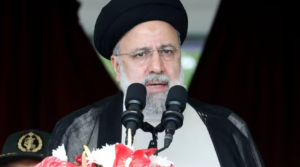A recent incident involving a helicopter carrying Iran President Ebrahim Raisi has caught international attention. On a routine journey, the helicopter experienced a “hard landing” in Iran’s East Azerbaijan province. While initial reports indicate no injuries, the event has raised concerns and underscored the challenges faced by Iran in maintaining its aging fleet of aircraft amidst international sanctions.

Incident Details: What Happened?
On a mission to inaugurate a dam alongside Azerbaijan’s President Ilham Aliyev, President Raisi’s helicopter encountered difficulties near Jolfa, a city on the border with Azerbaijan, approximately 600 kilometers northwest of Tehran. The helicopter made a “hard landing,” a term used to describe a landing that is more severe than usual but not necessarily a crash.
Iran’s state television reported the incident, noting the challenging weather conditions, including heavy rains, fog, and wind, which likely contributed to the mishap. The presence of Iran’s Foreign Minister Hossein Amirabdollahian alongside Raisi adds to the gravity of the situation, as top government officials were involved.
Context and Implications
Diplomatic Undertones
President Raisi’s visit to Azerbaijan was significant, particularly given the recent strains in Iran-Azerbaijan relations. The two nations have had a complex relationship, exacerbated by incidents such as the gun attack on Azerbaijan’s Embassy in Tehran in 2023 and Azerbaijan’s close ties with Israel. The dam inauguration, however, was a symbol of cooperation, being the third joint project on the Aras River.
Aviation Challenges
Iran’s aviation sector faces significant hurdles due to longstanding international sanctions. These restrictions have made it difficult for the country to procure parts for its fleet, which largely dates back to the pre-1979 Islamic Revolution era. This incident highlights the broader issues of maintaining and operating such an old fleet under challenging conditions.
Also Read : Iranian President Raisi Stance on Pakistan Kashmir Issue
Regional Tensions
The helicopter incident occurred amidst escalating tensions in the Middle East. Both Iran and Israel have recently exchanged missile strikes, adding to the volatile situation in the region. The presence of high-profile Iranian officials in a precarious situation could have further implications for regional stability.
Potential Outcomes and Future Considerations
While no injuries were reported, the incident could lead to several developments:
- Increased Scrutiny on Iran’s Aviation Safety: The incident may prompt Iran to seek international assistance or new strategies to modernize its fleet, despite sanctions.
- Diplomatic Maneuvering: The close call during a diplomatic mission might influence Iran-Azerbaijan relations, potentially fostering a more cautious and cooperative approach in future engagements.
- Regional Security Dynamics: With the Middle East already on edge, any perceived vulnerability or instability could affect regional security policies and alliances.
Conclusion
The “hard landing” of President Ebrahim Raisi’s helicopter serves as a stark reminder of the multifaceted challenges Iran faces, from maintaining aging infrastructure to navigating complex diplomatic waters and regional tensions. As more information becomes available, the incident may reveal deeper insights into the resilience and adaptability of Iran’s leadership and infrastructure in the face of adversity.